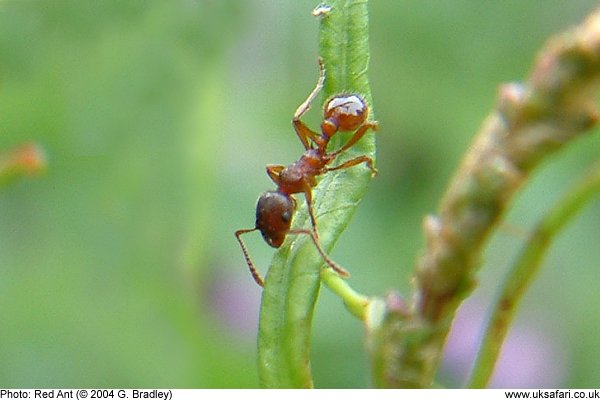 Ants
AntsIdentify It > Invertebrate Section > Ants >

Scientific name: Formicidae
Size: Approximately 3mm to 10mm long
Distribution: Found throughout the UK
Months seen: All year round
Habitat: Nests under walls, under stones, in old tree stumps and in grassland. Commonly found in gardens
Food: Some species are carnivorous, some are vegetarians, others are omnivores
Special features: Most of us are familiar with the red and black garden ants, but there are around 50 different species of ant in Britain. Many of them have strong jaws and are capable of stinging.
Unlike most other insects, ants have extra body segments between the abdomen and thorax. This 'waist' section is called the 'petiole'. Some species have one extra segment while others have two.
All ant species drink the 'honeydew' secretions from aphids.
Ants act like farmers to the aphids. They protect the aphids from predators, like ladybirds, and in exchange the aphids provide the ants with their sweet sugary droppings. Some ant species even keep aphids in their underground nests for the same purpose.

In late summer and early autumn, particularly in hot, stormy weather, swarms of flying ants can be seen. These swarms, sometimes called 'Ant weddings', are made up of male and queen ants which take to the air in order to mate. After mating the males die. The queens shed their wings and go off to set up new colonies.
Because ant weddings often happen just before a storm, when the air is very still, it gave rise to the folklore that ants could foretell the coming of
thunderstorms.
 Related Pages
Related Pages

 Popular Pages
Popular PagesAmphibians, Bats, Badgers, Beetles, Birds, Birds of Prey, Bumble Bees, Butterflies, Caterpillars, Climate Change, Deadly Spiders, False Widow Spiders, Frogs, Garden Spiders, Glow-Worms, Hedgehogs, House Spiders, Owls, Spiders, Toads, What's Out Now?
Copyright © 2024 G. Bradley UK Safari. All rights reserved | About Us | Links | Advertise | Contributors